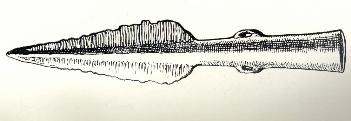Luton in the Bronze Age

A Bronze Age spearhead found in Sundon and illustrated in William Austin's History of Luton
The Bronze Age lasted from around 2350 BC, to somewhere around 700 BC. It was preceded by the New Stone Age or Neolithic and was succeeded by the Iron Age. At this time casting and use of bronze implements became widespread though flint tools were not abandoned straight away, the two co-existing for some time. In 1998 Ren Hudspith carried out a sample surface survey of a number of allotments in Luton, a total of some 20 hectares. The results were published in Bedfordshire Archaeology in 2001 (page 97). Scatters of Neolithic and Bronze Age flints were discovered at the following sites (with Bedfordshire Historic Environment Record references in square brackets):
- Stockwood Park, between London Road and Whitehill Avenue, some of these flints were fire fractured [HER17752];
- Wigmore Lane, between The Dell, Browbrook Vale and Eaton Green Road[HER17753];
- Toddington Road, off the main road between Harry Scott Court and the railway line [HER17754];
- Limbury, between Birdsfoot Lane, Riddy Lane and Truro Gardens [HER17755];
- Limbury, south of Riddy Lane [HER17756]
- Round Green, off Stockingstone Road [HER17757];
- Lewsey Farm, off Ravenhill Way [HER17758];
- Wigmore Valley Park, off Wigmore Lane [HER17760];
- New Bedford Road [HER17761]
The Bedfordshire Historic Environment Record reports a number of other Bronze Age finds in Luton. A geophysical survey was carried out at Butterfield Green, off Beech Hill in Luton, which produced evidence for a rectilinear and possible sub-circular ditched enclosure. This was followed up by a small excavation which produced a number of flints of a Neolithic and Bronze Age date as well as three ditches creating a boundary ditch, and pits that have been dated to the late Bronze Age to early Iron Age. A limited amount of late Iron Age and Roman evidence was also discovered [HER 15847].
Fieldwalking produced later Neolithic and Bronze Age debitage and eight retouched pieces from Great Bramingham Farm, along with Mesolithic and Medieval artefacts [HER 15224]. A later Neolithic and Bronze Age flint debitage and eleven retouched pieces along with Mesolithic and Medieval material was found in thre 1980s on Stopsley Common west of Bradgers Hill [HER 15227] and to the north of Stopsley Sports Ground a small scatter of burnt flints, clay and flint flakes were collected in the 1990s with dates ranging from the early Neolithic to the late Bronze Age [HER 16076].
The Historic Environment Record also notes that a late Bronze Age spearhead was found in Little Wood, Luton, south of Castlecroft Road. The object is now in Luton Museum [HER 14740]. Bronze Age collared urn fragments were found during the digging of house foundations in Spinney Road [HER 14674]. In 1904 local antiquarian Worthington George Smith found a group of three barbed and tanged arrowheads described as of the "Wessex type" in Leagrave [HER 1509].
Bronze Age features still visible, just, in the landscape are ring ditches showing up as cropmarks. One is on Stopsley Common. The Historic Environment Record notes that it is faintly visible from nearby hills [HER 967]. The other is on Hart Hill [HER 9087].